|
| |
|
Basic Facts and Early Career Edward J. Smith, better known to his friends as “E.J.” was born on January 27, 1850 in Hanley, Stoke-on-Trent of Staffordshire, England. He married Sarah Eleanor Pennington on January 13, 1887 at St. Oswald's Church in Winwick. They had one child, a daughter named Helen. Smith's career with the White Star Line began in 1880, when he served as fourth officer on Celtic0. He later commanded such ships as Majestic, Adriatic, Celtic, Coptic, and Germanic as well as Olympic and Titanic. Smith developed a loyal clientele of passengers who would sail only with him, no matter which ship he commanded. His firm but fair manner of command caused him to be a favorite among his crews as well. Smith's popularity as well as his experience led to his being the highest-paid captain in the North Atlantic shipping trade.
Mishaps and Mistakes
On February 16, 1899, Germanic capsized at her New York pier after ice accumulated in her rigging and superstructure.
On June 21, 1911, Olympic, sister ship of Titanic, was being moved into her slip at Pier 59 in preparation for her maiden voyage. A tugboat, O.L. Hallenbeck, was sucked against Olympic near her stern after a sudden reverse burst of Olympic's starboard propeller. Hallenbeck's stern frame, rudder, and wheel shaft were destroyed. White Star was sued for $10,000 but countersued and eventually both cases were dismissed for lack of evidence.
On September 20, 1911, Olympic collided with the Royal Navy cruiser Hawke in a narrow channel off the Isle of Wight. According to accounts, the two ships were sailing in the same direction on courses that were at first converging and then parallel, with Hawke off Olympic's starboard side. Both were going at about 15 knots, with Hawke at first overtaking Olympic and then dropping behind as the liner increased her speed. Suddenly, Hawke veered hard to port, ramming Olympic. Hawke's bow was badly crumpled, and Olympic stern was gashed, which caused flooding in two compartments and damaged her starboard propeller. Olympic was drydocked for repairs, which resulted in delays in the construction of her sister ship Titanic.
Titanic
On Sunday April 14, 1912, Captain Smith conducted church services in the First Class dining saloon. Throughout that day, ice warnings were received from various vessels via the Marconi wireless. Although some of these warnings were posted on the bridge, others either found their way into White Star Chairman J. Bruce Ismay’s pocket or were never delivered to the bridge because of some oversight on the part of the wireless operators.
That evening, Smith attended a dinner party in his honor at the a la carte restaurant and afterward returned to the bridge. He spoke with Second Officer Charles Lightoller, then at 9:25 he retired to his cabin. He left orders to wake him "if it becomes at all doubtful," but did not order that the ship be slowed down.
At 11:40 pm, under the watch of First Officer William Murdoch, Titanic struck an iceberg. Smith returned to the bridge and sent for the ship's designer, Thomas Andrews, and the ship's carpenter. Smith toured the lower decks with Andrews to assess the damage, including the now-flooded mail room and squash court. Andrews estimated that Titanic would founder within 60-90 minutes.
Smith ordered Chief Officer Henry Wilde to uncover the lifeboats. Other officers were sent to awaken the passengers, review boat assigments, and wake the other officers. Smith himself walked to the wireless shack, where he instructed Senior Marconi Operator Jack Phillips to send the call for assistance, "CQD." Junior Marconi Operator Harold Bride later joked to Phillips that he should send the new call, "SOS," and so Titanic became the first ship in history use the SOS code.
Up on deck, Lightoller requested and received Smith’s permission to start loading the women in children into the lifeboats. What Smith did during the loading of the boats and how he died are a matter of speculation. Some have said that he was the officer who shot himself; however, others insist it was Murdoch and still others suggest it was Wilde who committed suicide that night. Some survivors recalled seeing Smith on the bridge, and others claim they saw him jump off the deck at the last moment. In another story, it has been said that Smith swam to the overturned Collapsible B, held on for a moment, and then pushed himself away, whereas another version of this story had it that he carried a small child to the boat and then drifted away. Smith's body was never recovered. |
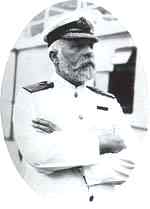 |
|
| |
|
| |
|
Basic Facts and Early Career Henry Tingle Wilde was born on September 21, 1872 in Liverpool, England. Sometime before 1900 he married Mary Catherine Jones, and they had six children. Two of the children, twin boys, died in infancy and Mary Catherine herself died on December 24, 1910 due to complications in childbirth. Wilde apprenticed on the sailing ships of James Chambers, then transferred to the Maranhan Steamship Company after obtaining his Second Mate’s certificate. Shortly after earning his Master's certificate he left Maranhan and joined White Star Line, where he served on the North Atlantic and Australian routes. His ships included Arabic, Celtic, Medic, and Cymric. Within 4 years after joining White Star, Wilde was named Chief Officer of Olympic. He was present (although not in command) at the time of Olympic's collision with the Royal Navy vessel Hawke in 1911.
Titanic
On April 14, 1912, Wilde came duty on at 2 pm. He was relieved by Second Officer Charles Lightoller at 6 pm. It is not known what he did after his left the bridge, nor what he was doing or where he was when Titanic struck an iceberg at 11:40 pm. However, he reported to the bridge shortly after the accident. After touring the ship with Captain Smith, the ship's designer Thomas Andrews, and others, Wilde was ordered by Smith to begin uncovering the lifeboats.
Official reports indicate that lifeboat 8 was loaded by Wilde. It has also been reported that Wilde went to Lightoller seeking handguns and that Wilde, Lightoller, and Murdoch obtained the weapons, which would later be used to keep order. At 1:20 am, lifeboat 10 was launched from the port side, loaded by Wilde. On the starboard side, Wilde assisted with the loading of collapsible C, which was lowered at 1:40 am. White Star Line Chairman J. Bruce Ismay and Mr. William Carter slipped into this boat before it was lowered.
How Wilde died is uncertain. He may have been working with collapsible A when the water overtook Titanic's bow, washing most of those in that area out into the ocean. There have also been reports that it was he who shot himself in the head as the ship went down. This has never been established, and it is generally believed that First Officer Murdoch was the officer who committed suicide. Both men had motive for such an act: Murdoch was at the helm of Titanic when it struck the berg and may have been overwhelmed with guilt, whereas Wilde had recently lost his sons and his wife and may have felt unable to go on. Neither man's body was ever found. Wilde's empty casket was laid to rest next to his wife.
|
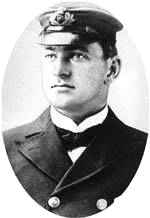
|
|
| |
|
| |
|
Basic Facts and Early Career William Murdoch was born on February 28, 1873 in Dalbeattie, Scotland. He was the fourth child and youngest son of Jane Muirhead and Samuel Murdoch. On September 2, 1907, he married Ada Florence Banks, a schoolteacher from New Zealand At age 23, Murdoch qualified for his Master's certificate. He later received his Extra Master's Certificate and was comrnissioned a Lieutenant in the Royal Naval Reserve. He began working on steamships and served on troopships to the Cape during the Boer War. He then joined the prestigious White Star Line and served on five of their ships, including Medic, Arabic, Adriatic, Oceanic, and Olympic before joining the crew of Titanic.
Titanic
On April 14, 1912, Murdoch was on duty on the bridge at 11:40 pm when Titanic struck the iceberg. He ordered the ship "Hard astarboard" and then closed the watertight doors in the boiler and engine rooms.
After the collision, Murdoch was in charge of loading lifeboats on the starboard side. How he died is not known. It has been reported that he shot himself in the head as the ship went down, but this story has never been confirmed. |
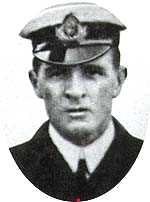
|
|
| |
|
| |
|
Basic Facts and Early Career Charles Herbert Lightoller was born on March 30, 1874, in Chorley, Lancashire, England. His mother died shortly after his birth, and his father later abandoned the family. Charles and his surviving siblings (he had lost a sister not long after his mother died) were raised by an aunt and uncle. Sometime around 1903 Lightoller married Sylvia Hawley-Wilson, an Australian whom he had met while she was traveling and he was serving on Medic. They later had five children. Lightoller began his apprenticeship aboard Primrose Hill at age 13. His next ship was Holt Hill, which was demasted during a storm in the South Atlantic and struggled into Rio de Janeiro. On November 13, 1889, the ship was again demasted in a storm and ran aground on an island in the Indian Ocean. The surviving crew, Lightoller included, were rescued by Coorong and taken to Australia. Lightoller next signed aboard Duke of Abercorn for his return to England. He then joined the crew of Primrose Hill again and survived a cyclone on the journey to Calcutta, India. While in India he received his Second Mate's certificate. Lightoller's next position was as Third Mate on Knight of St. Michael. The ship was carrying a cargo of coal that caught fire during the voyage. Lightoller's efforts to help the crew and maintain order on the ship during the fire led to his promotion to Second Mate. In 1895 Lightoller joined Elder Dempster's African Royal Mail Service where he spent 3 years and nearly died of malaria. In 1898, disillusioned with sea life, Lightoller joined the gold rush and traveled to Canada, where he prospected for gold in the Yukon. He was unsuccessful at finding gold, so he worked for a time as a cowboy in the Canadian west. After failing to make any money either as a prospector or as a cowboy, Lightoller returned home to England in 1899. He obtained his Master's certificate and began working briefly on cattle boats. Lightoller joined White Star Line in January 1900. He served on many of the same ships with William Murdoch, who would later be First Officer on Titanic. Lightoller started out as Fourth Officer on Medic, which sailed the Australian routes, then switched to for a time to the Atlantic routes. He spent a great deal of time on Majestic, working with Captain E.J. Smith. He was then promoted to Third Officer aboard Oceanic, then to Second Officer on the same ship, then to First Officer on Majestic.
Titanic
Titanic set sail on April 10, 1912. After a rough start that included a near collision with the New York, the next 4 days of the voyage were generally uneventful. On Sunday, April 14, the temperature dropped noticeably. The Marconi operators brought several ice warnings to the bridge during the day, but not all of them, and not all of those that made it to the bridge were posted for the officers on watch to see. Thus, although the officers knew that ice lay ahead, they were unclear as to the extent of ice and its accurate location.
At 6 pm, Lightoller relieved Chief Officer Wilde on the bridge. During his watch, he asks Fourth Officer Boxhall to chart the ship's position and orders the ship's carpenter to check the fresh water supply. At about 9 pm Captain Smith arrived on the bridge and spoke with Lightoller for several moments before retiring. LIghtoller then orders that the lookouts be alert for icebergs. Lightoller was relieved by First Officer Murdoch at 10 pm. When the ship struck the iceberg at 11:40, Lightoller was in bed and nearly asleep. He rose and got dressed but remained in his quarters, knowing that he would be summoned if something had happened. Fourth Officer Boxhall arrived a few minutes later to bring Lightoller up on deck.
Lightoller was ordered to begin swinging out and uncovering the lifeboats. At about 12:25 am he requested and received Captain Smith's permission to load the women and children into the boats. Although he knew the situation to be serious, Lightoller did not know that the ship was sinking. He began loading the lifeboats on the port side, beginning with lifeboat 4, which he planned to load from the promenade deck. After discovering the windows on that deck were locked, he moved on to boat 6, into which he loaded about 25 people, including Molly Brown.
At this point Chief Officer Wilde asked Lightoller if he knew where the firearms were located. Lightoller, Wilde, and First Officer Murdoch went after the weapons and each took a pistol. Returning to the deck, Lightoller loaded boat 8 with 28 people, followed by boat 12, and boat 14. Lightoller refused to allow any men on board, with the exception of Major Peuchen, whom he had allowed into a lifeboat when it was discovered the boat was short one seaman.
The windows on the promenade deck were opened at last and Lightoller, with the help of Colonel Archibald Gracie and Clinch Smith, finished loading lifeboat 4. He began to realize that Titanic was in serious danger. He lowered boat 2 at 1:55 am. By 2 am, only the four Englehardt collapsible boats remained, and Lightoller began loading collapsible D. He had a difficult time locating women, so he allowed some men into the boat. Chief Officer Wilde ordered him to go with the boat, but he refused. He then began working on collapsible B, which was tied down to the roof of the officer's quarters. As Lightoller and others worked to free the boat and push it onto the deck, crowds of people began to surge toward the rising stern. The bow plunged into the sea, and collapsible B was washed off the deck.
Rather than join the crowds on the stern, Lightoller jumped from the deck of the ship into the freezing water. He fought off shock and began to swim away from the ship, but was suddenly sucked under and pinned against a ventilation grate. Suddenly a blast of hot air came up through the grate and threw him clear of the ship, but he was dragged down again and pinned to another grate. Somehow, he got clear of the second grate and rose to the surface, where he found himself alongside the overturned collapsible B. He grab hold of a length of rope attached to the boat and floated with it.
As Titanic sank, the forward funnel came crashing down into the water, where it fell near collapsible B. The impact caused a huge wave that washed collapsible B (and Lightoller) clear of the ship. Lightoller then pulled himself aboard the collapsible, where he stood upright on the boat's bottom with a group of other men. From that position he watched as Titanic stood up on end and plunged into the water. With Lightoller on the collapsible was a group of about 30 men, including Colonel Gracie, firemen and other crewmen, the assistant cook, and Junior Marconi Operator Harold Bride. Senior Marconi Operator Jack Phillips may also have been aboard at some point, but this is not confirmed and he was lost in the sinking. As the men stood on the boat it began sinking and also began rolling about in the churning waves. To keep the boat from capsizing, Lightoller ordered the men to move with the waves, leaning to the left, to the right, or standing straight as the situation required.
As morning broke and Carpathia appeared on the horizon, the men on the sinking collapsible were rescued by two lifeboats. Lightoller boarded boat 12 and it to contain 10 people more than its 65-person capacity, which caused it to ride low in the water. Lightoller took command of the boat and it began rowing toward Carpathia. He was the last survivor to board the rescue ship.
After Titanic
In 1913 Lightoller returned as First Officer of Oceanic. During World War I he was made a lieutenant. By Christmas 1915, he was commander of HMTB 117, an old torpedo boat. On July 31, 1916, they spotted a zZeppelin flying over London and fired at it. They missed, but distracted the zeppelin and thus spared London from further bombings that night. Lightoller was awarded the Distinguished Service Cross for his efforts. He went on to command several other ships during the war. When the war ended he was a full Commander. He returned to White Star for a brief time, but was never given command of his own ship, despite his skill and experience, and eventually resigned.
In June of 1940 that Lightoller had his last sea adventure. German tanks had trapped 400,000 Allied troops (most of the British Expeditionary Force) near the French port of Dunkirk on the French/Belgian border. On May 31, Lightoller was asked to bring his yacht, Sundowner, to Ramsgate so the British Navy could take her to Dunkirk and use her to help rescue the troops. Lightoller insisted that he command his yacht, and he ultimately rescued more than 100 soldiers.
Charles Lightoller died on December 8, 1952 at the age of 78.
|

|
|
| |
|
| |
|
Basic Facts and Early Career Herbert J. Pitman was born near Somerset, England on November 20, 1877 to Sarah Marchant Candy Henry Pitman. Among other positions he held, Pitman spent 3 years as an officer on a sailing ship before moving to steamships. He served the Blue Anchor Line for 1 year, followd by 6 months with the Shore Line, and 5 years with the White Star Line.
Titanic
Captain Smith ordered Pitman downstairs to see whether the water was coming in very fast. He watched as bags of registered letters floated around the mail room. Pitman reported to the captain and returned to the boat deck, where he helped uncover the lifeboats. When the loading of the boats commenced, he assisted First Officer Murdoch on the starboard side. Murdoch ordered Pitman to take command of lifeboat 5. It was not until after he had left Titanic that Pitman realized the ship would sink. Until then, he had assumed they would return to the ship in the morning.
After Titanic |
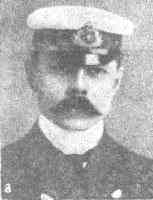
|
|
| |
|
| |
|
Basic Facts and Career Joseph Groves Boxhall was born in Hull, Yorkshire, on March 23, 1884. Boxhall served his apprenticeship with William Thomas, Liverpool, and later served as an officer with the Wilson Line of Hull.
Titanic
Boxhall came on duty at 8 pm on April 14. Shortly before the collison he left the bridge, but he was returning when the warning bell in the crow's nest rang. He was present on the bridge when First Officer Murdoch ordered that the watertight doors be closed and then felt the impact as the ship struck the iceberg. Shortly after the collision Boxhall was sent to inspect the ship, going several decks down and as far as he could in the steerage section, but he saw no damage. When he returned to the deck he was sent to fetch the carpenter and then to wake Second Officer Lightoller and Third Officer Pitman.
Boxhall helped Chief Officer Wilde uncover the lifeboats. As the officer in charge of navigation, he was ordered to calculate the Titanic's position so that Captain Smith could order the distress signal to be sent. At 12:25, Boxhall noticed the lights of a nearby ship and tried to signal with the Morse lamp but was unsuccessful. He then began firing rockets from the bridge and over the course of an hour fired 8 rockets into the night sky.
Around 1:45 am Boxhall assumed command of lifeboat 2 which was lowered from the port side. Although it could hold 40 people, it carried only 18. Boxhall suggested returning to the site of the sinking to rescue swimmers but the other passengers in the boat refused. During the night, he fired off green flares and rowed. At about 4 am he set off one last flare, just as Carpathia came into view. Once aboard Carpathia, Boxhall reported to the bridge, where he was the first to inform Captain Rostron that Titanic had foundered.
After Titanic |
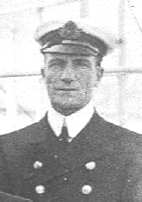
|
|
| |
|
| |
|
Basic Facts and Early Career Harold Godfrey Lowe was born on November 21, 1882 in Conwy, Wales. At the age of 14, Lowe ran away from home to begin his career on the sea. He served on the West African coast, for 5 years before joining the White Star Line, for which he served on both Belgic and Tropic.
Titanic
After helping to load the emergency lifeboat and lifeboat 14 on the port side, Lowe took command of boat 14 and thus left Titanic. As his lifeboat was lowered, he fired his pistol down the side of the ship to scare off the hordes of panicked passengers trying to climb aboard. When the boat reached the water, Lowe ordered the crew to row away from the ship. He then lashed his boat to several others and moved passengers around among the boats to distribute them more evenly.
When Titanic finally sank below the surface and the cries of those in the water began to subside, Lowe asked for volunteers from his boats to accompany him back to the site of the sinking to pick up survivors. They then rowed back to and among the wreckage, where they found four survivors, one of whom died later. Lowe's was the only lifeboat of the 15 or so afloat to return to the scene for survivors.
As the morning wore on, Lowe raised his lifeboat's sail, and when Carpathia arrived he was able to sail toward it. En route to the ship, he stopped to take one collapsible in tow and to pick up the passengers of another collapsible.
After Titanic
In 1913 Lowe married Ellen Marion Whitehouse, with whom he had two children. Like all of the surviving Titanic officers, Lowe never commanded a ship of his own in the merchant service, although he reached the rank of commander while serving the Royal Naval Reserve in World War I. Lowe died on May 12, 1944, and was buried in North Wales.
|
 |
|
| |
|
| |
|
Basic Facts and Early Career James Paul Moody was born on August 21, 1887 in Scarborough, England. His parents were John Henry Moody and Evelyn Louise Lammin. Moody passed his Master's examination in April 1911. His first ship with the White Star Line was Oceanic, from which he was transferred to Titanic. Little else is known about him.
Titanic
Moody's actions after the collision have been told primarily through recollections of survivors. He is believed to have helped with the loading of lifeboats 12, 14, and 16, and Ruth Becker later recalled that it was Moody who helped her into boat 13. Fifth Officer Lowe remembered working with Moody on the loading of boats 14 and 16. The last known sighting of Moody was by Second Officer Lightoller at approximately 2:18 am. At that time Moody was helping in the efforts to launch Collapsible A. He died sometime thereafter, but the exact circumstances of his death are unknown. He was the only junior officer to perish in the disaster.
|
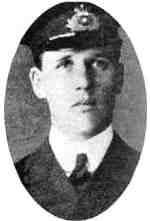
|
|
| |